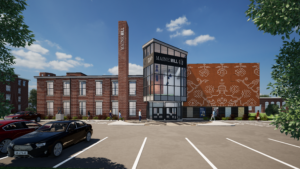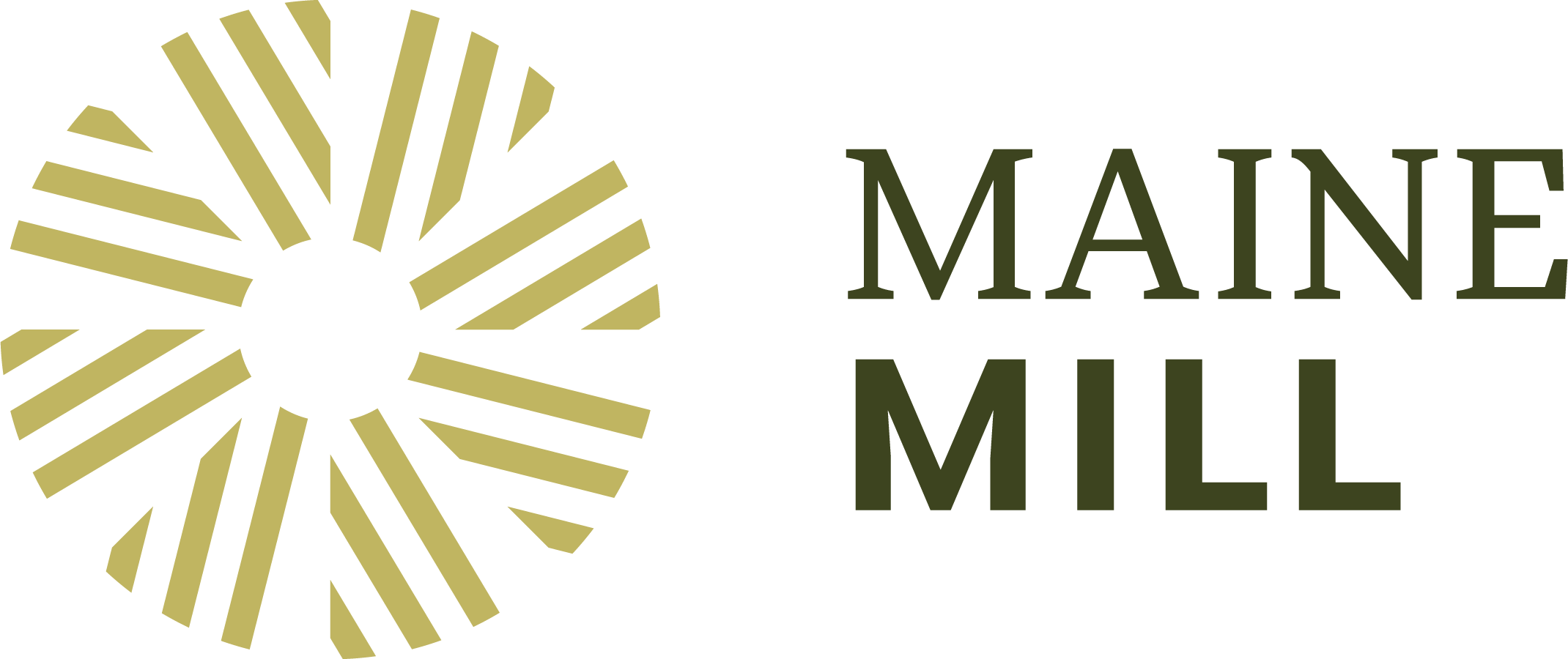 Maine MILL Mission Statement
Maine MILL Mission Statement
We celebrate the told and untold stories of workers to foster community connections and inspire future creativity and ingenuity.
1.0 Introduction
Maine MILL in Lewiston, Maine is requesting proposals for the design of its permanent exhibition in its new location. This RFP is for a complete design of the exhibition’s displays, lighting, audio-visual components and related materials. Our goal is to open the new museum in the summer of 2025. Construction is planned to begin in spring 2024 and is anticipated to take 12 months.
2.0 Background and Exhibit Concept
Preserving our past, in the present, to inspire the future.
Maine MILL has a unique collection of over 10,000 artifacts and hundreds of recorded oral histories exploring the history and heritage of yesterday and how it influences our today and tomorrow. The highlights include over 200 original Bates textiles (bedspreads, tablecloths, sheets); 5,000 archival documents and photographs; 350 original hand-drawn designs created by the Bates design department; more than 200 industrial-size silkscreens; many pieces of industrial machinery; and roughly 300 recorded interviews and oral histories.
The collection began with salvaged machinery and artifacts saved by local community members when the last textile mill closed in 2001. As word spread, more objects came into our collection—expanding to include other industries and stories that helped to shape our community over the years. We continue to add to our collection to include a wider range of perspectives and experiences in order to tell our community’s whole story, a story that continues to unfold.
Textiles, Shoes, Bricks and the story of the power of the Androscoggin River form the foundation of the collection. The majority of artifacts were found in the deserted mills, shoe shops and brick yards of Lewiston and Auburn, salvaged on their way to the dump, or donated by former workers and their families. The collection consists of both modern and vintage locally produced textiles, machinery involved in local production, personal items and tools owned by the workers, and photographs of work and social life.
Rather than divide the permanent exhibition into sections about each of these industries, the goal of the new permanent exhibition is to use themes to connect the stories to each other and to issues present today (i.e. innovation; labor; creativity; etc.). The hope is also to use the personal stories from previously collected oral histories to tell the larger narrative of the existence of these broader themes in modern day.
The process for determining themes and for approval of the overall concept would be led by an Advisory Group, allowing for an opportunity to display the collection in ways that acknowledge the inequities and injustices within our history. Written content will be generated by Maine MILL staff and members of the Advisory Group. The Advisory Group will meet on multiple occasions to guide, develop, advise, and author interpretive and programmatic elements for this reinstallation.
The exhibit design should be sure to include engaging audio/visual content and opportunities for viewer engagement and participation.
3.0 Target Audiences
The permanent exhibit should appeal to all audiences and find ways to engage and thoughtfully connect history to the present moment. We expect thousands of school children to visit the museum each year and the exhibit must allow for tours as well as self-navigation. For history lovers and many people who are directly connected to the mill history, the story of the machinery will be a draw; for tourists and others with no direct connection to the history of the area, the exhibit design must find ways to draw people in and make connections.
4.0 Project Size and Budget
An estimated size for the exhibit is approximately 5,000 square feet. The budget for this project will include all design fees and completion of audio-visual and interactive components. Fabrication of exhibition displays, lighting and related materials will be bid out once the design is completed and approved.
5.0 Eligibility
This competition is open to exhibit designers with a strong portfolio of successful designs for museums, arts & cultural centers and/or historical societies.
6.0 Project Scope
The exhibit designer selected for this project will develop the conceptual through construction designs for review and approval by Maine MILL. The selected designer is responsible for all exhibit and exhibit-related components, including the integration of audio-visual or interactive components.
The designer will work as a partner with Maine MILL and the Advisory Group, under the direction of Maine MILL’s executive director.
Completion of the design phase of the new museum is tentatively set for April 1, 2024, with construction projected to begin for the new building on July 1, 2024.
The responsibilities of the designer for the project are as follows:
• Review Maine MILL’s concept and goals for the permanent exhibit and establish the full scope of the project;
• Evaluate the proposed schedule and budget as they apply to the scope of the project;
• Create a preliminary budget for development and installation of the exhibit, based upon approved concept drawings. The budget will provide a line item breakdown of expenses for design, fabrication and installation;
• Prepare a design and fabrication schedule detailing the critical path, key milestones and deliverables for the entire project;
• Prepare plans and renderings that illustrate the key components of the exhibit, how these components are integrated with one another, and how the exhibit will be configured;
• Finalize a projected fabrication and installation schedule;
• Assist in the selection for the contractors to build the exhibit (if needed);
• Supervise production and installation of the exhibit according to the project timeline.
7.0 Client Responsibilities
As the client for the exhibit project, Maine MILL will provide the following materials and/or services:
- Assistance in photographic research and selection (as needed);
- Providing content with appropriate documentation;
- Direction in selection of artifacts/objects;
- Providing meeting space and coordinating meetings with project designer and Advisory Group
8.0 Submission Procedures
Interested firms or individuals should submit a proposal including the following elements (in this order):
Content
a) One page cover letter including a statement of your interest in this project and relevant qualifications and experience to fulfill the RFP requirements;
b) A summary of recent design projects and how they relate to this design task;
c) A list of at least three client references from recent projects (name, phone, email);
d) A list of personnel and brief professional overview of those who would be directly involved in this project for its duration;
e) Assessment of the firm or individual’s current workload and ability to devote necessary time & attention on this project;
f) A breakdown budget estimate covering:
o Research, planning & design
o Construction/fabrication & installation
g) A draft project timeline;
h) Payment terms & conditions
Format
We prefer your proposal to be sent as an electronic file in pdf format; however, hard copies are acceptable.
1) For hard copies, three complete copies of the proposal should be sealed in one package and labeled “Maine MILL Exhibit Design Proposal.” The package should be addressed to Rachel Ferrante (see below).
2) For electronic files, subject line should say Maine MILL Exhibit Design RFP Submission. We will only accept pdf format attachments. Electronic submissions should be addressed to rferrante@mainemill.org.
Proposals must be submitted via email or in person by August 31, 2023 at 5pm.
9.0 Evaluation Criteria
The Maine MILL team and selected board members will review and evaluate all proposals. Their evaluation will be based on the strength and creativity of previous design projects, and the perceived ability of the firm or individual to implement the project on budget and on time. The winning proposal will demonstrate a clear “feel” for the goals and objectives of the new permanent exhibit.
10.0 Tentative Schedule
Call for proposals August 14 – August 31, 2023
Deadline for submissions August 31, 2023 at 5pm
Interviews with selected
Design firms/individuals September 2023
Contract award On or about October 1, 2023
11.0 Contact information
Questions about the project or proposal requirements should be directed to:
Rachel Ferrante
Executive Director
Maine Museum of Innovation, Learning and Labor (Maine MILL)
Tel: 207-333-3881
Email: rferrante@mainemill.org
